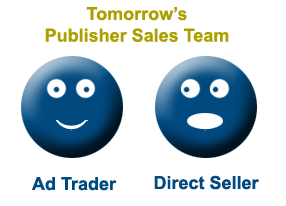 Publishers of large, “premium” content websites are starting to wonder: “How are we going to survive? Are we ever going to make the CPMs, revenues and margins that we’re used to?”
Publishers of large, “premium” content websites are starting to wonder: “How are we going to survive? Are we ever going to make the CPMs, revenues and margins that we’re used to?”
Today, tons of advertising inventory is going unsold and being allocated to ad exchanges and networks. And, the advertisers with budgets are eating up the opportunity to buy at scale as CPMs plummet.
With more sites and content being created everyday, it might seem that the large publisher is going to go the way of the newspaper business requiring cutbacks on staff and content which had been supported by the sweet margins of direct sale CPMs.
Balderdash!
Tortured, “premium” content, large web publisher – your future is the exchange.
To be clear, we’re not suggesting that the direct sales team is going to be dissolved – quite the contrary, the sales team will divide into two important functions.
The Direct Sales Team
In the future, the direct sales team will be selling custom, integrated sponsorships and ad deals that get the advertiser’s brand closer to the large site’s brand and its valuable users. Of course, these deals will command high CPMs and due to their complexity will make the direct sellers an important and essential part of the sales team.
For the most part, display inventory will no longer be a part of the direct sellers’ annual sales goals as the inventory – premium and remnant – achieves its best performance through the exchange model.
The Publisher Ad Trader
A large site’s display inventory will be managed by the Ad Trader who will not just offer the inventory for sale on the exchange or send it off to yield optimization companies like AdMeld, Rubicon Project or Pubmatic as publishers do today.
In the future, many of the rapidly evolving tools from these optimizers will be placed in the hands of a site’s trader or trading team enabling enhanced optimization and segmentation of inventory by leveraging trading tools with a publisher’s own proprietary data – such as registration or behavioral data – and increase the value (CPMs go up or stabilize!) to advertisers of inventory once seen as garbage remnant, for example.
In turn, the direct response or brand advertiser’s target audience will become increasingly specific and willing to pay more for inventory as web analytics in the future prove ROI and can be directly mapped from the demand generation of a display ad campaign to the purchase of an advertiser’s products or services.
Pork Bellies Be Damned!
Technology won’t turn advertising into pork bellies as Wenda Millard famously said early last year. It will enable the exchange to provide transparency for advertisers and publishers on value and at scale. The exchange model and its technology enables increased, efficient hypertargeting and moves closer to every marketer’s wet dream: one-to-one marketing.
Moreover, publishers will be aggressively buying on the exchange for their own advertisers and, like any trader on an exchange, profiting from arbitrage.
Publisher vertical ad networks do this today, albeit clumsily. Like advertisers, publishers will be able to buy futures and spot market display ad – or search ads, or video ads, etc. – inventory from any site on the exchange, rather than the vertical network only, down to a single ad impression in real-time. Publisher ad traders may serve an ad for their advertisers or they may sell it back to the market and take the difference.
The Good News
Technology of the exchange increases the yield on inventory and creates trading opportunities for publishers as they become expert members of the exchange. Whether its perceived as premium or remnant, potentially any publisher impression is premium on the exchange for the right advertiser or… trader!











